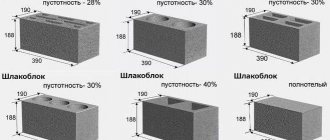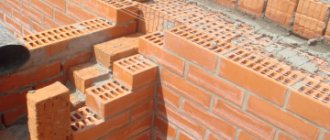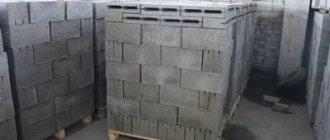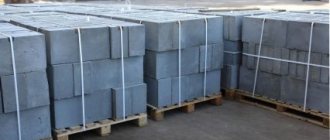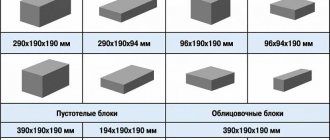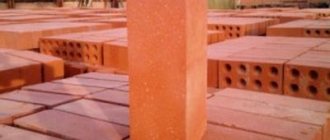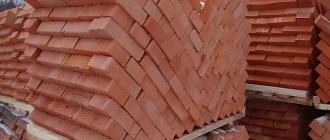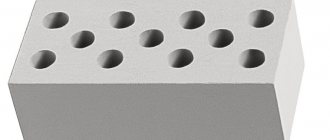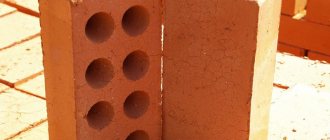One of the many difficulties of construction lies in the difficulty of correctly calculating the required amount of wall material. This problem can be solved in different ways, so we consider how many bricks are in a pallet, why this particular container has become increasingly used for transportation, and how piece blocks are stacked to simplify transportation.
Pallet - a convenient container for transporting bricks Source iz-kirpicha.su
Kinds
The types of single bricks transported in pallets or pallets are quite diverse. Typically, the following main categories are distinguished.
- Red - made from natural clay, through molding and firing in an oven. The finished product combines excellent strength characteristics, not too much weight - 3.6 kg for a full-bodied version, and resistance to external weather influences. The dimensions of the brick block are 215x12x6.5 cm.
- White is silicate, made not from clay, but from quartz sand, the mass of which reaches 90% of the total volume. In addition, the composition contains lime and various additives. The process of molding the product takes place by dry pressing followed by processing of the raw materials in an autoclave under steam. Its high strength characteristics make it an attractive choice for finishing and cladding. But it won’t be possible to lay a stove or pipe out of white brick - when heated above 200 degrees Celsius, it will simply burst.
- Fireclay. Refractory bricks for laying stoves, fireplaces, and chimneys are made from finely crushed fireclay and special types of clay. Available in several of the most popular size ranges, depending on the brand, it can be transported on platforms of different sizes.
- Facing. Available in a hollow version, with different patterns of recesses. It has standard dimensions of 250x90x50 mm. There is also a yellow variety, produced in both ceramic and clinker or hyper-pressed form. The size of one product in this case will be 250x120x65 mm.
The types of pallets used when transporting bricks are also of great importance. For example, when it comes to size range and load capacity, only two options are used in the transport sector. Standard pallets or pallets have a load capacity of no more than 750 kg, with a platform size of 1030x520 mm. There are also enhanced options. In this case, the pallet has dimensions of 1030x770 mm and can withstand a weight of up to 900 kg. There are also Euro pallets used in international transportation that meet the requirements of the GOST 9078-84 standard. Their dimensions are 1200x800 mm, the maximum load capacity is 1500 kg. All products for transportation are made from natural wood, with bars as stiffeners.
This is interesting: Specific heat capacity of bricks: ceramic, silicate and refractory
Standard number of pieces in one pallet
Red brick
When building a private house, red is often used. For its production, various types of clay are used, which is subjected to a firing process. The result is a very durable product. The weight of a red solid brick will be 3.6 kg, and a hollow one - 2.5 kg. Red perfectly resists precipitation.
The standard size of a pack of red bricks is 250x120x65 mm. But the volume of red bricks depends on its type. When it comes to single solid ones, you need 480 of them, and they weigh 3.45 kg/piece. When you need to buy a red one-and-a-half hollow stone, its package includes 308 pieces. But different manufacturers have their own number of bricks and the number will depend on whether the bricks are of regular size or non-standard size.
Dimensions and tonnage of the pallet
Today, standard packaging platforms made of wood or metal with different load capacities are used:
- 750 kg – have a flooring measuring 1.03 x 0.52 m;
- 900 kg – respectively 1.03 x 0.77 m;
- 1500 kg – Euro pallet (GOST 9078-84) measuring 1.2 x 0.8 m.
These are the main indicators that set the upper limit for pallet loading. To determine the maximum number of bricks that can be placed on one pallet, it is enough to divide its carrying capacity by the weight of one stone.
“In a Christmas tree” or with overlaps - these are the names of the main ways to compactly lay a brick stack on a platform and reduce the amount of breakage during transportation. Unfortunately, none of them allows you to quickly count how many bricks are in one pallet by simply multiplying the rows and stones.
Ceramic brick
The most popular material, which in many such calculations is a kind of standard. The density of solid ceramic blocks is 1800 kg/m3, the dimensions of single 1NF products are also known: 0.25x0.12x0.065 = 0.00195 m3. This means that a standard red brick will weigh 3.5 kg. For slotted, this figure is lower - an average of 2.4 kg.
When determining the capacity of pallets, the same calculations are made for other types of building blocks, after which the data obtained is correlated with the load-carrying capacity of the pallets.
| Brick execution | Average weight, kg | Load capacity | |||||
| 750 kg | 900 kg | 1500 kg | |||||
| Things | volume, m3 | Things | volume, m3 | Things | volume, m3 | ||
| Full-bodied | |||||||
| Single | 3,5 | 214 | 0,42 | 257 | 0,50 | 428 | 0,84 |
| One and a half | 4,2 | 178 | 0,47 | 214 | 0,56 | 357 | 0,94 |
| Double | 6,9 | 108 | 0,45 | 130 | 0,54 | 217 | 0,90 |
| Hollow | |||||||
| Single | 2,4 | 312 | 0,61 | 375 | 0,73 | 625 | 1,22 |
| One and a half | 3,2 | 234 | 0,62 | 281 | 0,74 | 468 | 1,24 |
| Double | 4,8 | 156 | 0,65 | 187 | 0,77 | 312 | 1,29 |
The figures given in the table are estimates and are tied to the average weight of standard ceramic blocks. For each manufacturer, they may differ slightly, depending on the density of the red brick and the chosen method of laying it on a pallet. At the same time, for standard wooden pallets manufactured in accordance with GOST 18343-80, there is a limit on the height of the stack - no more than 1 m.
For convenience, experienced builders recommend using the following data for Euro pallets:
- 1NF (single) – 420 pieces;
- 1.4NF (one and a half) – 390;
- 2.1NF (double) – 200.
Sand-lime brick
These building blocks are made from quartz sand with the addition of lime and are autoclaved after pressing. They have good strength indicators from M75 to M300, but at the same time they cannot boast of weather resistance. And although red and white bricks have the same dimensions, the weight of the latter is slightly higher (3.7 kg versus 3.5).
Does this mean that they put it on the pallet in smaller quantities? Not really. The reason is that for silicates, other platforms can be used - wood-metal, holding up to 450 pieces. Their sizes are larger: 1.915x0.6 or 1.74x0.52 m. Here, a lot depends on the manufacturer itself - what kind of packaging it usually uses for its products. Most often, a brick pallet comes with the following number of blocks:
- Single – from 240 to 300.
- One and a half - 350-380 pieces. Here you need to be careful, because some offer only 180 units of brick, while others offer a large volume of 670-700 units (as a rule, these are facing blocks).
- One-and-a-half slotted - depending on its hollowness, it is placed on a pallet of 380-672 units.
- Double slot – 448 pieces.
Also, sand-lime brick, like red brick, can be supplied loose, that is, without packaging. However, in this case, the amount of combat during transportation increases significantly.
Fireproof (fireclay) brick
Kiln blocks are made from special clay and fine chamotte chips. They are highly resistant to temperature changes, withstanding up to +1600 °C, and to active substances. The choice of brands and sizes for this material is very large, so we will focus only on the most popular types of fireclay bricks:
- ShB-5 is a fireproof block weighing 3.4 kg. With straight stone dimensions of 230x114x65 mm, up to 385 pieces or 0.66 cubic meters can be placed on a pallet.
- ShB-6 - aka “flood”. It has a slightly different aspect ratio and dimensions 250x114x40 mm. The package holds up to 296 bricks, each weighing 2.4 kg. The total volume of the stack is 0.34 m3.
- ШБ-8 - with dimensions 250x124x65 mm, weighs 4.2 kg and is stacked on large platforms of 625 pieces (1.26 m3).
An end or edge wedge made of fireclay clay, regardless of size, is packaged in 415 units per pallet.
We have given generally accepted standards for determining the number of bricks of different types in a standard pallet. However, please note that manufacturers may make other decisions on their own to optimize transportation. So, having received preliminary figures for calculations, do not forget to check the actual number of bricks before purchasing them.
How much does a pallet of bricks weigh?
In order to answer this question, you need to know the mass of the pallet, the mass of the package, the mass of each unit of products, as well as their quantity in the package. It is possible to increase the weight by 50-70 kg in the absence of film and storage in a humid environment. This must be taken into account when loading the car. And if the packaging is damaged, you can always make a claim to prevent an accident from occurring. Also, you should not buy pallets on which the distortion is clearly visible. The weight depends on how many and what kind of bricks are in the pallet. For example, voids reduce this indicator, but often manufacturers themselves invent their shape and size, so it will be quite difficult to make at least an approximate calculation.
Let's take a few facts into account again:
- The density of hollow brick is 1100 kg/m3, and that of solid brick is 1400 kg/m3.
- The stack volume on two different pallets will be:
0.52*1.03*1 = 0.5356 cubic meters
0.77*1.03*1 = 0.7931 cubic meters
Accordingly, the small pallet will fit:
- hollow brick: 0.5356*1100 = 589 kg
- solid brick: 0.5356*1400 = 749 kg
And on a large pallet it will fit
- hollow brick: 0.7931*1100 = 872.5 kg
- solid brick: 0.7931*1400 = 1110 kg
These calculations can only be taken into account as an approximate indicator, since bricks from different manufacturers can vary greatly in density and even slightly in geometric parameters. You can find out exactly how many required bricks are in a pallet only from the manufacturer when purchasing
An approximate calculation can lead to large financial losses, so it is best to rely on exact figures. It is for this reason that bricks are not counted by mass, but are calculated by quantity or in cubic meters. Also for this purpose, a load cell is installed on the fork of the loader, which accurately determines the weight during loading. Usually the weighing error is up to 3kg, which is enough to load the platform accurately
You can find out exactly how many required bricks are in a pallet only from the manufacturer upon purchase. An approximate calculation can lead to large financial losses, so it is best to rely on exact figures. It is for this reason that bricks are not counted by mass, but are calculated by quantity or in cubic meters. Also for this purpose, a load cell is installed on the fork of the loader, which accurately determines the weight during loading. Typically, the weighing error is up to 3 kg, which is enough to accurately load the platform.
What else needs to be taken into account when calculating?
A brick of no more than 1 meter in height is placed on one pallet. When calculating, it is very important to understand in what units the brick is sold. If you know the area of the masonry, and the building material is sold in cubic meters, then you need to recalculate the quantity in the same units of measurement using accurate calculations.
Table of the number of bricks in a pallet
Each vehicle has its own carrying capacity, so when calculating the number of pallets, it is necessary to take into account the weight of the cargo along with the pallets so as not to overload the vehicle. If you are not sure of your calculations, it is better to consult with a manager who will help you buy the appropriate option.
in Novosibirsk it sells a wide range of bricks with delivery. Contact our managers, they will help with calculations.
How many pallets can fit in a KAMAZ, truck, long vehicle?
Let's assume that the pallet size is 520mm*1030mm. About 32-33 pallets of bricks will fit in a truck; a long length will take about the same amount. KAMAZ can only be loaded onto 10-12 pallets. Now, knowing this information, you can determine as accurately as possible which transport is best for you for transporting bricks.
When the main work is completed, the question of finishing the premises arises. Some people use dry building mixtures for this, which give a unique look to brick walls. This is exactly what is discussed in the article “A Look at the SSS from a New Angle.” There you will find a lot of useful tips in this regard. And in the “Design” section, you will find other nice tricks for interior decoration.
Characteristics of red sand-lime brick
This is how experts describe the composition of red sand-lime brick:
- 92-94% sand;
- the remaining part is impurities.
- if there is emptiness inside, a fragment with dimensions 250 × 120 × 88 is 3.9 kg;
- if it is filled inside, the weight increases to 5 kg;
- 250x120x65 equates to 3.7 kg, as for the hollow material, its weight is 3.2 kg.
The weight of a pallet made from facing, block, stove or any other briquette directly depends on the composition and manufacturing technology. On average, a briquette weighs 2.5 kg, but pallets are also different:
- a regular surface has a size of 520×1030 mm;
- the maximum possible platform assumes a size of 770 × 1030 mm.
Pay attention to the angle of inclination of the bricks - it may differ; the material can be placed assuming an angle of 45 degrees, or vice versa, following a flat surface. For single material 65 mm, more fragments are required, and for one and a half 88 mm, fewer.
Most often in stores they buy the M75-M150 brand. What do the numbers on the label mean? This is the probable number of kilograms that the material is able to withstand when taken into account per 1 square meter. cm. That is, to get the number of products, you need to use the formula: Platform area / Brick area. And then it’s easy to calculate the number of briquettes placed in a pallet: Number of products × Number of rows of masonry.
Another calculation option is if builders need to calculate the number of cubes of material in a platform, use the size of briquettes. If we are talking about a single product, this is 513 briquettes per cubic meter. For one and a half you will need 379 pieces.
GOST stipulates the rules for laying bricks on pallets. Products can be laid in a “tree”, “on a die” and “on an edge”, using cross dressing. The weight of 1 pallet should not exceed 850 kg.
The total mass of a pallet with bricks consists of the sum of two terms - the mass of bricks and containers.
Finished packages with goods must be reinforced with metal tape in accordance with GOST 3560. It is possible to use shrink or stretch film in accordance with GOST 25951 or 10354.
When storing products in pallets, they are separated by brand and type, and they are arranged into single-tape stacks in one tier. It is allowed to place packages on top of each other, but not higher than two tiers.
Manufacturers often ignore these GOST requirements and offer products in packages that exceed the permissible weight by 4 times. Each manufacturer arranges its products based on personal considerations. Laying bricks at an angle of 45 degrees or laying them out in horizontal, tight rows results in weight differences. Some manufacturers leave space when laying to reduce the load on the lower rows and not deform them during transportation, which also leads to weight discrepancies.
You need to find out from the seller what the weight of 1 pallet will be.
This is interesting: How to lay brickwork correctly
Advantages of brick material
- The main advantage of brick is strength, this indicator is denoted by the letter M, and subsequent numbers indicate the load that the material can withstand.
- The material also has a long service life; such buildings are considered the most durable; the façade may not require repair work for about 100 years.
- The material is resistant to low temperatures and can withstand a large number of freezing cycles. This indicator is denoted by the letter F, and the number after it indicates the number of cycles. The frost resistance indicator affects the durability of the structure.
- Brick is considered an environmentally friendly material; it contains clay, water, and sand; no chemical additives are used. Thus, the material does not emit substances that are harmful to health or pollute the environment.
- The product is called breathable, since it allows air to pass through, and mold and mildew do not form on the walls. The material is not susceptible to damage by insects and rodents, and also does not rot.
- Thanks to the brick walls, the humidity level in the room is not exceeded, thus creating a microclimate favorable for comfortable living. With proper construction of walls, even in the most humid or cold weather, the interior will remain warm and dry.
- The cost of the material is affordable, and you can do the work yourself, which will help you save on costs.
- The brick facade has an aesthetic appearance. This material is used not only for the construction of walls, but also for facing work.
Preliminary calculation of ceramic type
Brick quantity calculation table
To determine the amount of units of building material on one packaging site, you need to know the mass of one stone and the tonnage of the flooring.
Ceramic wall material is the most in demand, so it often acts as a standard for calculations. It is made from clay and some additives, then fired. The product has excellent strength and is weather resistant.
The density of a solid stone is 1,800 kg/m³, its size is: 0.25 * 0.12 * 0.065, i.e. 0.00195 m³. The weight of a standard stone is 3.5 kilograms (1,800 * 0.00195).
Facing brick is lighter. It is used for external decoration of buildings. The weight of a single one is in the range of 1.32–1.6 kg, one and a half – 2.7–3.2.
The approximate capacity of the platform for some types of ceramic bricks is shown in the table:
| Type of building material | Average weight, kg | Pallet tonnage | |||
| 750 | 900 | 1 500 | |||
| Quantity per pallet, pcs. | |||||
| Full body: standard | 3,5 | 214 | 257 | 428 | |
| thickened | 4,2 | 178 | 214 | 357 | |
| With voids: standard | 2,4 | 312 | 375 | 625 | |
| thickened | 3,2 | 234 | 281 | 468 | |
| Facing: single | 1,5 | 500 | 600 | 1 000 | |
| thickened | 3 | 250 | 300 | 500 | |
The table reflects the average capacity calculated from the average weight of the ceramic product. For different manufacturers, the amount of building material in a pallet may differ. This depends on the density of the products and the method of their installation.
It is generally accepted that Euro stands can accommodate:
- single - 420 pieces;
- one and a half - 390 pieces;
- double - 200 pieces.
Options for laying bricks on a pallet
Amount of masonry material for 1 m3
If we consider an ordinary stone, its length will be 250 mm and width – 120 mm. The presented sizes may be different, because the product in question can be divided into 3 groups based on thickness. Taking into account the wishes of the customer, the manufacturer offers several standard types of masonry material, which is characterized by a change in thickness.
What is the price of a solid single brick indicated in this article.
Now let’s look at the amount of masonry brick for 1m3, taking into account the thickness:
- Single – thickness value 38mm. This product is universal and is used in the construction of walls, pillars, and enclosing structures. The average weight of a stone that works well in compression will be 3.6 kg. In its pure form, 1 m3 contains 513 pieces. When building a wall, taking into account the seam, 400 pieces will be used.
- One and a half – thickness value 88 mm. A pallet of such stones contains 379 pieces. If you build a structure taking into account the seams, then 305 pieces will be used per 1 m3.
- Double – thickness value 138 pieces. The presented product is purchased when it is necessary to quickly erect a structure. In its pure form, 1 m3 contains 255 pieces. When building a wall including a seam, you will need 200 pieces.
What are the dimensions of a single building brick can be seen from the article
What is a pallet
Pallets are a kind of structure designed to ensure the safe shipment, transportation and storage of brick blocks, also called pallets. More often, their price is included in the cost of ordering building materials, but sometimes they are paid separately. These devices are manufactured in compliance with various technological standards, which ensure:
- ability to withstand significant weight and dimensional loads;
- compliance with quality standards;
- transportation of a certain number of cubic meters of building materials;
- compliance with the necessary technical parameters;
- use during the operational shelf life (metal products - no more than two years, wood products - up to a year).
Where to get containers
Having decided to buy a packaged batch, you need to decide where to find pallets. The easiest way is to order them along with the building material. Many manufacturers today include the price of containers in the cost of a batch of blocks. Practice shows that this is beneficial for those who build a lot and constantly buy bricks. Unloaded pallets can be reused. And now you can save money here.
You can look for used pallets. This product is available. Separate purchase of new brick pallets is also available.
Types of pallets
In order to ensure the safety of bricks during transportation and storage, as well as to facilitate loading and unloading operations, special pallets are used. The design features and technical characteristics of pallets intended for storing and transporting bricks are regulated by GOST 13843–80 dated January 1, 1981. The use of pallets provides:
- significant time savings during loading and unloading;
- almost 100% safety of building material at all stages, from storage to unloading at the construction site;
- possibility of using forklifts.
Pallet design features
A pallet for transporting and storing bricks is in many ways similar to conventional pallets, but has a number of significant differences:
- increased load capacity;
- availability of special fasteners for the use of special equipment;
- the possibility of using forklifts is provided.
Varieties
For ease of use of pallets, the following designations are adopted:
P
– pallet;
ABOUT
– the pallet is equipped with supports;
TO
– the pallet has special hooks;
D
– the pallet is made of wood;
M
– the pallet is made of metal.
Classification
Depending on the design features and materials used, the following modifications of pallets for transporting and storing brick blocks are distinguished:
UNDER
– the most common modification (pallet equipped with wooden supports), used for transportation by road and rail;
POM
– reinforced version on supports with a metal base;
PDKM
– a pallet with a wooden base, reinforced with metal elements. To facilitate loading and unloading operations, it is equipped with special hooks.
Modifications POD and POM have additional cross bars to increase the load-bearing capacity. To secure brick blocks during transportation, triangular stops are provided.
Dimensions and load capacity
To transport bricks, three types of pallets are used, the dimensions and load capacity of which are regulated by GOST 9078-84:
| Modification | Dimensions, mm | Load capacity, kg |
| Standard | 1030x520 | 750 |
| Reinforced | 1030x770 | 900 |
| Euro pallet | 1200x800 | 1500 |
One unit of measurement
Brick is one of the most popular building materials. It is often used for the construction of a wide variety of residential and commercial buildings. And to make it convenient to deliver piece goods to customers, manufacturers use special packaging - a metal-reinforced wooden pallet.
It has special fastenings for special equipment, which help to remove and load a large number of bricks at once in one step. Pallets for bricks are made of different designs, the type of which is indicated by one letter:
- “O” is a rectangular platform with supports.
- “P” – standard pallet.
- “K” – a pallet with hooks that make it easier to grip.
- “D” – wooden shield.
- “M” – metal product.
POD - a wooden pallet on supports Source palletlps.com There are combined designs.
When selling a large batch of bricks and transporting it, “POD” (a wooden pallet on supports) and “POM” (a flat panel on supports) are most often used. The type of placement of piece material on them is selected taking into account the transport by which the brick will be transported to the site. The “herringbone” and masonry with dressing have proven themselves well. Choosing the second method allows you to fill the tray very quickly. The bricks are stacked on edge. For fixation, each new row is bandaged, and then the finished block is packed in film. This greatly simplifies the loading and unloading of building material and significantly reduces the percentage of its damage.
Laying method “on edge” Source depositphotos.com
Before this, transportation by shaft was used. The brick was manually thrown into the back of the car, and then unloaded as well. This took a lot of time. It was faster when the brick simply fell to the ground. The percentage of spoilage here often reached 60%. And this is very unprofitable.
The use of pallets minimized the percentage of spoilage. There is no longer a need to attract loaders and pay for their work. Pallets turned out to be convenient both during loading and unloading, and during transportation and storage. If you know in advance how a pallet of bricks is filled, how many bricks fit on one panel, it’s easy to independently calculate, buy, deliver and unload the most consumable wall material on site.
When choosing the herringbone laying method, the bricks are laid at an angle of 45 degrees. The assembly turns out to be strong, it is of higher quality, but it is difficult to assemble. If you do something wrong, the slide will quickly disperse and crumble.
Herringbone laying method Source loader22.rf
When a pallet of bricks is assembled in a herringbone pattern, more blocks are placed on the board. Since the structure has good stability, there is no need to install additional blocks. There is no need to tie up each row and then pack the bale in film. And this also helps you save.
Capacity of different bricks
It is logical that the amount of brick that fits on a pallet depends on the size of the brick itself and the pallet. The capacity of the pallet depending on the type of brick is as follows:
- Red. Hollow brick is lighter, so it is placed on a large pallet of 420 - 480 pieces. It all depends on the percentage of hollowness. Working bricks are placed on a pallet from 200 to 400 units.
- Silicate. The quantity of this brick varies from 240 to 380 units. The facing or slotted one is a little lighter, so it fits up to 700 pieces on a pallet. Since the mass of the brick itself is much greater than that of red brick, reinforced pallets are used for its transportation.
- Fireclay products for laying a furnace are placed on a pallet in the amount of 415, 385 or 625 pieces. It all depends on the size and type of products, as well as the type of pallet.
- The facing material has different characteristics. Standard size bricks fit 275 pieces on a pallet. The hollow material can hold up to 480 units. All this data can be clarified with the manufacturer, and the number of pallets to be ordered can be accurately calculated and vehicles for transportation selected.
How many squares and cubes of bricks are in a pallet (pallet)
Brick weight including pallet
Standard sizes of bricks
The presented container for transporting bricks is presented in the form of a wooden lattice, where the material is laid. Its weight is 30-40 kg.
But a cube is laid out on the substrate. This is very convenient for the seller, who can very quickly count the goods being sold. A product made from clay can have a design with voids inside or a solid one. The greater the number of cavities, the lighter the stone. For a single brick with cavities, the weight will be 2.7 kg. The weight of such products will be 1.3 tons.
If we consider a red solid single stone, then it is placed on a specially created cover - 200-300 pieces. The weight of the product can reach 3.1 – 4 kg. Its weight will be 1.2 tons.
The weight of the red facing depends on its dimensions. As a rule, such a product is produced hollow, and in shape it can be single or one-and-a-half. If you buy a single one, then its quantity is 325 pieces, and one and a half - 240 pieces. The weight of such products will be 1.4 tons.
The fireproof chamotte ShB-5 weighing 3.4 kg is placed in the pallet in the amount of 385 pieces. The weight of one package will be 1.3 tons. The weight is similar for a pallet with ShB-24.
The video shows how many bricks fit in a pallet:
Total weight
The total weight of the pallet is also of great importance. When choosing a freight transport, it is this aspect that needs to be taken into account, and not the sheer weight of the products. In particular, a small pallet 103x52 cm weighs 15 kg without loading. The mass of the brick loaded onto it can be up to 1017 kg - that’s how much 275 pieces weigh. single solid sand-lime brick. If the pallet is not fully loaded, you can get the weight using simple calculations. The amount of brick is multiplied by the mass of one product:
Preliminary calculation of the required quantity of bricks provides optimal opportunities for ordering building materials not individually or in bulk, but in convenient packaging, pallets. This approach is actively practiced in construction stores and in factories where products are produced. Having the most accurate information at your disposal, you can easily cope with the purchase of the required amount of bricks.
For more details on brick calculations, see the video below.
Options for laying material on pallets
To prevent the brick from being severely damaged, it is laid on stands in the form of a herringbone, maintaining an angle of 45 degrees. In this case, minimal pressure is created on the bottom layer.
You can also place it in a dressing, which will require additional elements and dressing tapes. The first method is considered the most relevant, since the bricks will not spill out of the pallet, and more material will fit on it. The maximum amount of bricks should be placed on the pallet.
To calculate the amount of material on a pallet, taking into account its size, you need to calculate the area of the stand itself, the surface area of one brick, and the resulting figure is multiplied by the number of layers. After all calculations have been completed, it is necessary to check in advance whether a given amount of material is allowed to be transported on a pallet.
Average price of one pack per cubic meter
In most cases, the price for bricks is set by the seller per piece, and not per pallet.
Table 1 - Cost of various types
| Variety | Quantity per pallet, | Price, rubles |
| Hollow ceramic face – silicate | 420–480 | 8 600 – 9 300 |
| 308–352 | 5 900 – 7 400 | |
| 400–440 | 4 900 – 5 600 | |
| 334–380 | 5 100 – 5 900 | |
| Solid ceramic ordinary-silicate | 330–400 | 5 120 – 5 800 |
| 240–380 | 3 300 – 4 600 | |
| 224–360 | 3 600 – 5 600 | |
| 400–436 | 3 300 – 3 600 | |
| 280–340 | 3 100 – 3 700 | |
| 200–240 | 3 400 – 4 100 | |
| Torn (corrugated) | 307–436 | 5 200 – 6 500 |
| Special, fireproof | 330–360 | 11 200 – 12 200 |
Determining the capacity of silicate blocks in a pallet
Silicate products are obtained by autoclave processing of pre-compressed quartz sand with an admixture of lime. It has good heat and sound insulation and is frost-resistant. Despite the same size, its weight is slightly more than that of a standard red brick: 3.7 kilograms.
Sand-lime brick size
For laying silicate, wood-metal platforms measuring 1.915 * 0.6 or 1.74 * 0.52 meters are often used. How many bricks are in a pallet depends on the manufacturer and the type of packaging container they use. Typically the following number of units can be accommodated:
- single - 240-300 pieces;
- one-and-a-half - 350-380 (cladding comes in blocks of 670-700 pieces);
- one and a half slotted - 380-672 (depending on the level of voidness);
- double slotted — 448.
Sometimes manufacturers sell half-packs containing 180 units.
Thickness of different types of masonry
How are building materials placed on a pallet?
Placing brick blocks on pallets is done in several ways approved by GOST. The height of the bricks in the package is also regulated and should not exceed 1 m. At the same time, the types of briquettes do not affect the laying method; the same technologies are used to place backfill, refractory, oven and other types. Methods for arranging ceramic products on a pallet:
- Bandaging rows. Brick blocks are laid on the board edgewise or flat, depending on the types, sizes, and methods of transportation. After this, they are secured using horizontal cross-knitting.
- "Herringbone". This is the safest way to lay brick briquettes. It consists of placing the transported products at a strictly 45º angle to the center, and they are fixed at the edges of the pallet with triangular bars. Using this method allows you to transport building materials without scattering or compromising its integrity.
A brick package can fit a certain number of blocks, which depends on the type, weight, size and presence of voids in the material. There are varieties of ordinary, cinder block, stove, Karasevsky, backfilling, ordinary (M 150) material from which brickwork is made. They are used in the construction of load-bearing walls, interior partitions, the construction of stairs, fences, as well as in the construction of basements.
It all depends on the type
Before you start making calculations, you need to know that the height of the product can also be completely different and different from the standards already established for it. First of all, you need to decide what type of building material you plan to use. The following types of similar products are distinguished:
- single (size 25cm*12cm*6.5cm);
- one-and-a-half type (25x12x8.8 cm);
- double element (25*12*13.6);
- used for the base (25*12*6.5);
- block (25*6*6.5cm);
- euro (25*8.5*6.5cm).
This list speaks of the smooth and plump body type. The hollow type (torn) will be even lighter, which means there is a possibility that the number of bricks in the pallet in this situation may increase. Packaging is also important. But even having decided in advance on the future type, you cannot be sure from this how many bricks will be in the pallet.
Everything depends on them - according to GOST, the following load capacity is distinguished:
- up to 750 kg;
- up to 900 kg.
The size of the first will be 520*1030 mm. In the second case, the width will be slightly larger - 770 mm.
Standard size of ordinary brick
The working material, due to its parameters, is used in various types of masonry. Its dimensions became the basis for a unified standard adopted by GOST.
- single 1 NF – 250x120x65 mm;
- one and a half 1.4 NF – 250x120x88 mm;
- double 2.1 NF – 250x120x138 mm.
Attention!
An ordinary stone manufactured according to technical specifications may not correspond to the NF format. Dimensions are measured as actual.
Figure 1. Standard sizes of ordinary bricks
Variations in the amount of content
Above are standard sizes that can be used if you need to know the number of bricks in a pack. And in order to find out exactly how many of them will be needed for construction, you should arm yourself with the following simple formula: divide the number of products required for masonry by the number that is in the package. This will give the necessary figure for the scale at which the packages themselves will need to be purchased.
There may be the following options:
- The sleek look in standard sizes will come in quantities of 275 per pack.
- A one-sided torn type will have a different indicator - 307 elements.
- A dihedral of the same torn type with dimensions 220x90x65 mm will contain 375 pieces.
- The base type has much more units - 480 in one container.
of brick in a pallet can also depend on the individual height of the product. In this case, the following approximate calculations for each known type are appropriate:
- There are approximately 420 single elements in a pallet.
- The number of one-and-a-half bricks in a pallet can reach 390 units.
- The amount of sand-lime brick in a double-type pallet will be only 200 elements.
How to calculate the quantity?
To prepare for construction, you need to draw up an estimate that includes the required volume of material in m3
Its transportation is carried out on a wooden container, so it is important to calculate how many pieces of ordinary brick are on a pallet.
Quantity on pallet
When calculating the number of products on a pallet, three factors are taken into account:
- dimensions of ordinary bricks;
- pallet dimensions;
- way of laying products.
Photo 2. Laying material on a pallet
The weight and dimensions are known; information about the pallets will be required. Devices for safely transporting building material are made of wood, metal, or a combination of both.
Common sizes:
- 520×1030;
- 770×1030.
Attention! The number of products on one pallet may vary depending on the weight of the stacked products.
If the blocks are placed in the shape of a cube, then it is easy to calculate how many ordinary bricks are on a pallet. You will need to calculate the area of one masonry product and a pallet, then use division to find out the quantity in one row. Multiplying this data by the number of rows, we get the total number. When stacking using the “Christmas tree” method, such calculation is irrelevant.
Manufacturers usually indicate the number of products on a pallet. Averages:
- single – 200-400 pieces;
- one and a half - 200 pieces;
- double – 200 pieces.
Figure 3. Methods for laying stones on a pallet
Quantity per cube
When planning construction, the amount of material is sometimes calculated in cubes. Having found out how many ordinary bricks are in m3, you can determine the amount of costs for constructing the structure. Proper calculation will help to avoid unnecessary expenses, and will also eliminate the need to purchase additional material, since stones from different batches differ in shade, which is especially important for facial products.
Its standard dimensions will help you calculate the amount of material. To calculate the volume of one product, it is necessary to multiply all its parameters 0.25 × 0.12 × 0.065 = 0.00195 m3.
Then the total volume (1 m3) is divided by the volume of one stone 1: 0.00195 = 512.8 or 513 pieces. To calculate how many ordinary bricks of other formats are in a cube, the same principle is used. Taking the dimensions of a one-and-a-half and a double product, we get 379 and 242 pieces, respectively.
Table 4. Amount of bricks in m3
Attention! Manufacturing companies do not adhere to a general rule regarding how many pieces of ordinary brick to place on a pallet. They are guided by the features of their packaging lines, ease of transportation and cargo safety rules. An informational video will tell you about the features of laying building bricks of standard sizes:
An informational video will tell you about the features of laying building bricks of standard sizes:
